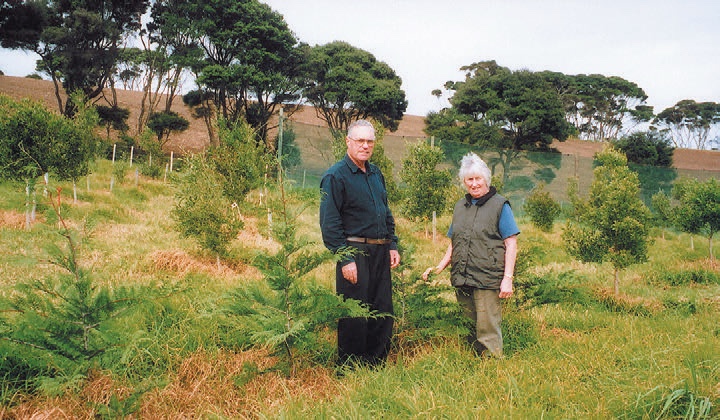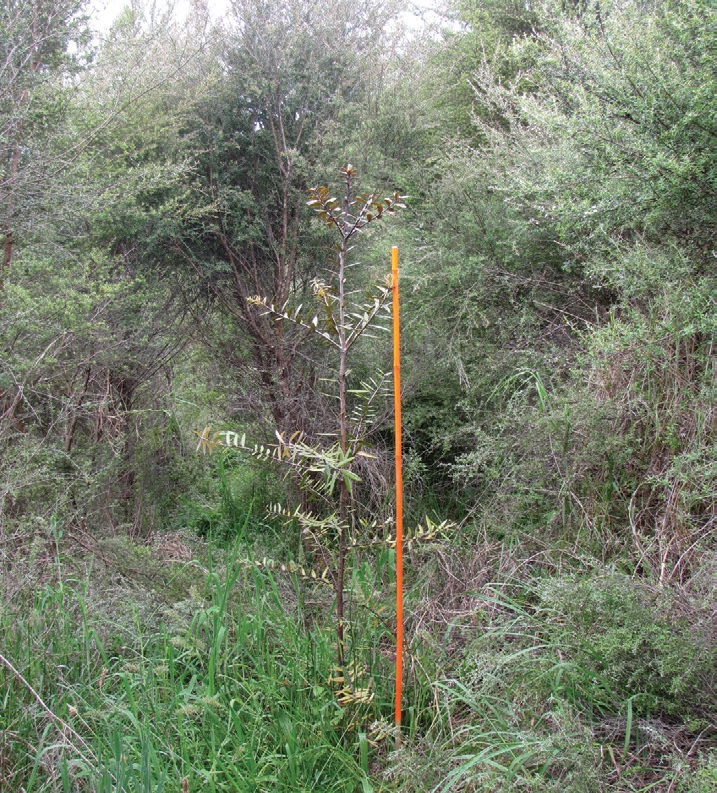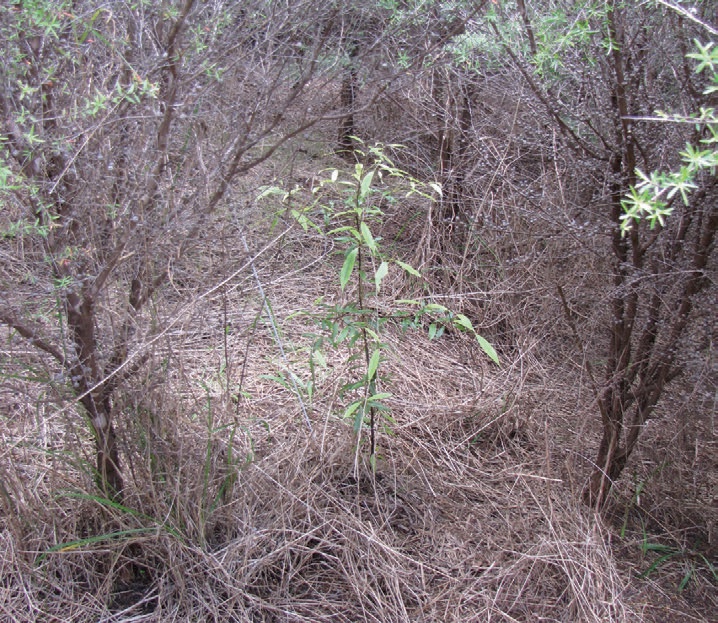A planted indigenous forestry project
Harley and Margaret Gray, New Zealand Tree Grower February 2012.
In the November 2005 issue of Tree Grower we wrote an article entitled ‘Starting from scratch’ which described the early stages of our small forestry project on Kaipara South Head. This is a retirement project for two city folk which has turned out to be very rewarding. Here is an update with a focus on our native plantings.
Location
We have a 22.6 hectare property on the harbour side of South Head with spectacular sea views. It is rolling sand country exposed to all winds with a significant salt loading from the west. Frosts are not a major problem, we have no possums and annual rainfall is 1100 to 1200 mm. Summer temperatures peak around 27°C.
The land was formerly part of a larger dairy farm, and at the time of purchase the only trees were two old kanuka. A total of 16 hectares were set aside for grazing carrying 36 heifers for a neighbouring dairy farm. Soil testing revealed satisfactory nitrogen, potassium and trace element levels, a very low Olsen P and sulphur, and very high levels of manganese. Some of our problems may be due to toxicity from this element. The steepest slopes with the worst pasture were chosen for tree planting, keeping the better land for pastoral and possible horticultural use in the long term.
Shelter
Initially we used Ovens cypress as shelter plantings in the hope that there would be a future timber yield. These trees did not do well, commonly snapping off at ground level in high winds when three or four years old, and also were susceptible to canker. Some experts have suggested that this arose because the trees were not Ovens cypress, but they came from a reliable source, and others in this area have had the same problem. We now use radiata for shelter, and they have proved useful for erosion control on an exposed one hectare area of almost bare sandstone. Sand country pine is favoured for framing timber where the rate of growth is slower than on more fertile sites, so these trees may have a future value and will not be pruned.



The planting programme was due mainly to the fact that the project began in when we were in our mid-sixties and we needed to get the crop trees in before our physical abilities deteriorated. We would have done better by establishing shelter and waiting longer.
Scope of forestry
We have participated in the farm forestry eucalypt trial initiated in 2004 where Eucalyptus fastigata have done well, and in provenance trials for Melia azedarach and Grevillea robusta organised by Wade Cornell. The former species have struggled but the latter thrive. We have also joined the redwood clonal trial set up by Wade and have used the best clones for supplementary plantings. This species has done surprisingly well given the long hot dry summers and the winds.
We would have done better to delay planting of the crop trees until the shelter was more established. Redwood is a distinct possibility in this latitude and soil type. We have had some success with black walnut in a sheltered site with good soil, but wind has still been an issue. We have a small plot of blackwoods but they struggle. Our major interest was to grow natives for timber and the rest of this article will focus on that.
Natives for timber
As we explored South Head we found lots of puriri and miro with some rimu in remnant patches of bush. In the mid 19th century when European settlement began, the peninsula was mainly covered in scrub. There were extensive areas of remnant kanuka, but little manuka as this species was wiped out in the 1950s by a fungus.
In the southern parts there were deposits of kauri gum, and some large logs are said to have been recovered from swamp land. The soil type is less sandy in these areas, whereas in our part we are dealing with late quaternary sand deposits. The Woodhill State Forest of radiata pine to our west was planted in the mid 20th century partly to control the relentless advance of sand. The eastern shore of the Kaipara has different soils, and at the time of settlement this was covered in dense kauri forest. It was the foundation of the economic development of the area in the early stages.
The portents were that we could grow kanuka and manuka as a nurse crop, and embark on planting totara and rimu with some confidence, but kauri might be difficult. Locals counselled against this species, but being emotional and stubborn, we went ahead with our dream anyway.
Site
We chose 1.5 hectares on a moderately steep north facing slope with poor pasture and no existing trees. An adjacent patch of mature gorse was cleared using a chain saw and then burnt. The area was fenced professionally with a 7-strand boundary style fence. The top of the slope was planted with three rows of cypress and gaps blanked out with radiata.
Subsequently three vertical lines of crow’s nest poplar were planted to reduce winds blowing across the slope. There was an old stand of kanuka on council land to the west and some shelter from a bluff and neighbour’s pines to the east. A 30 metre wide stand of eucalypts was planted in the middle of the plot for extra shelter.
The site was too steep for machine access so almost certainly had little fertiliser applied over the years. It was sprayed off in stages with glyphosate before to planting.
Nurse planting
We used kanuka and manuka, at a ratio of three to two, grown in root trainers at a spacing of 1.5 metres across the slope and two metres up the slope. Each tree was given one fertiliser tablet. A total of 3,200 trees were planted in the winter of 2004 and a further 4,000 trees in 2005, with a planting density around 4,000 stems per hectare.
We estimate that the overall survival is around 80 per cent. The seven-year-old trees are around three metres high with crown closure and reasonable suppression of grasses. Kikuyu was a problem in the early phase as was onion weed. Gardoprim and Gallant were used for release over the first year or so.
After we had started this regime we became aware of Ian Barton’s views that blackwood are a better nurse for kauri than kanuka. Unfortunately we were too far advanced to change tack.
Totara
The first tranche of 570 of totara were planted in 2005 when the nurse was a year old. The plants were in root trainers and were sourced from Phillips Nurseries in Te Kuiti. The trees were 30 to 40 cm high and the density was 2,500 stems per hectare, and one slow release fertiliser tablet was given to each tree. They were released once at six months. Form pruning to remove double leaders began two years after planting
Given the density and survival of the nurse trees, the whole plot was very tight. The main reasons were to allow for losses and to have a density which would reduce side branching.
The following year 500 trees sourced from Northland were planted in a similar fashion in a plot adjacent to the first tranche. These trees were in small pots. The general management plan was the same except that no fertiliser tablets were used for the second planting. The trees from different provenances appear to be performing similarly, there being no obvious difference from using fertiliser tablets or by type of container.
There is a difference related to the age of the nurse tress. There is now an annual requirement to trim back the nurse trees because of over-topping and crowding of the totara. Given the planting density this is not an easy task. The totara planted into the one-year-old nurse are growing at a similar rate to the nurse so that wind protection and branch restriction is being achieved. In the second planting where the nurse is a year older the need for nurse trimming is much greater to prevent over-topping.
The survival of the totara is estimated to be around 85 per cent and thinning will be required in the future. Where there are blanks in the nurse crop, lateral branching is more marked. Currently the six-year-old trees are around 2.5 metres high and stem diameter around 5 cm in the best trees. Around 10 per cent of the trees develop double leaders
The lessons learnt are that the nurse was a little tight and perhaps 3,000 stems per hectare would give the same biological effect with less need for pruning of the nurse. For Kaipara conditions, with this density of the nurse, planting the crop trees after one year is preferable to planting at two years as this reduces the need to trim the nurse. Given the good survival of the totara a reduced planting density would have saved money. At least there should be plenty of choice in choosing the final crop trees.
David Bergin has surveyed all our native plantings. He plans to establish a sample plot in the middle of our totara planting in the near future.
Rimu
A thousand trees were bought from Treefrog Nurseries, it used to be Albany Nurseries. The company went into receivership shortly after we bought the trees and the provenance was not established. The trees came in PB3s, and varied between 40 cm and 70 cm in height. Spots were sprayed off and one slow release fertiliser tablet was placed in each hole. One easterly plot contained 600 trees and a more westerly plot on the same slope had 400 trees which on average were slightly higher than those in the eastern block. Planting at a density of 2,500 stems a hectare was in 2007 when the scrub was two years old. Over the first eighteen months releasing was with Versatil and Gallant.
About half the trees were lost over the first summer despite hand watering the western block on two occasions. For the next summer this block was mulched with pine peelings. At one year all trees were fertilised with a small handful of general garden fertiliser and with phosphate at 26 and 34 months. Pruning of double leaders and trimming of the scrub has been performed annually.
Survival is estimated to be around 25 per cent to 30 per cent and is better in the western block which was more pampered where the trees are healthier. The scrub in the poorer eastern block is definitely more stunted than in the west, so there is some general factor affecting this area. Possibilities include more exposure to salt winds coming over the harbour and differences in groundwater seepage into the slope. It is clear that in both areas the rimu do better when partly shaded by the scrub. In contrast to the totara, the planting density for the scrub and rimu is about right for Kaipara conditions.
It is difficult to be certain, but there is a clear impression that the trees have responded to the phosphate. The attrition is such that thinning will not be required for some time, but eventually will be needed in 20 to 30 years. We would also have done better by waiting another two years for scrub growth before planting the rimu.
Kauri
In 2007 a total of 940 trees in PB3s were bought from Treefrog Nurseries. Of these 240 trees were less than 60 cm high so they were held over for planting in 2008. Spots were sprayed and planting was at 2,500 stems a hectare using one fertiliser tablet for each tree. Releasing was carried out and the silviculture regime was the same as for the rimu. The 2007/8 El Nino summer which created such havoc with the rimu was even more devastating to the kauri, where more than half of the trees were lost.
In October 2008 all trees were mulched. The summer was a little wetter and fewer trees were lost. We used the same fertiliser regime as for the rimu, but there was less obvious benefit to the kauri.
For the first planting the scrub was two years old and the second planting was mainly into the blanks. The kauri seem to be happy with more space, but like the side shelter. If scrub was to be used again as a nurse we would plant at a lower density. Despite the losses thinning will be required in the future. Lateral branching is not such a worry with rimu and kauri as these trees are self- pruning.
We have watched carefully for die back disease and none has been detected. Careful boot hygiene is followed if we visit affected areas, and is enforced on visitors. Currently we have trees up to 1.8 metres tall with many healthy specimens.
Other natives
We have subsequently planted small numbers of miro, matai, tanekaha, kohekohe, tawa, kahikatea, taraire and rewarewa. All have struggled, particularly the taraire and tanekaha, and the kohekohe are subject to insect damage. At this stage we have no useful information on these species.
Legal issues
We have chosen not to become involved in the ETS. We felt that we are too small to sustain the compliance costs, the future of the Kyoto protocol is uncertain, and we have little confidence in any proposition involving future government policy.
The objective of our project is to produce natives for timber rather than seeking a QE II covenant in order to subdivide. The ability to fell natives is governed by the Resource Management Act administered by the local authority, formerly the Rodney District Council, now Auckland City. Forestry is a permitted activity under the rules. We have kept invoices for trees, taken photographs before and after planting and kept the council fully informed including the clear intention that the trees are for milling.
The actual milling of timber is governed by the Forests Act administered by MAF. Once the planting was finished, we applied for registration as a planted indigenous forest. The main element is that there needs to be no existing trees before planting begins. We had existing aerial photographs together with our own documentation outlined above. We had a visit from a MAF official from Whangarei who checked all the paperwork, walked through the block taking GPS measurements and photographing examples of each species. The duly signed certificate was received exactly three weeks from the time we first contacted MAF, and at no cost. A letter was sent to the director of MAF complimenting him on an excellent process. This registration allows the Minister to issue a milling certificate after application in the future. We also hope that the registration will help the granting of permission to fell the trees in the future. Options such as sustainable forestry will be decided to by future generations.
Summary
While the attrition rate has been high this has been a most rewarding way of enjoying retirement. We are in the process of starting a walkway through the stand using a route which will cover good examples of most of the species. We are concerned that kauri dieback will arrive eventually. This problem was not widely known when we began planting.
We realise that the legal framework will change over the years, but we have done all we can under the current legislation. The kauri may be harvested around age 60 as the sap wood is useful. The other species will need much longer to mature.

 Farm Forestry New Zealand
Farm Forestry New Zealand

